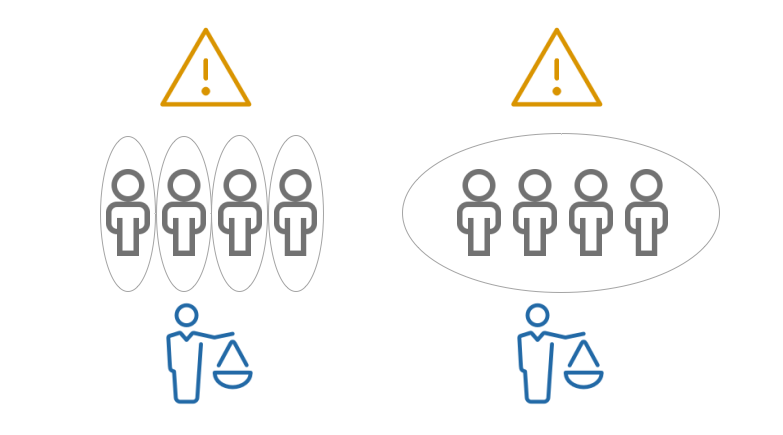What can I do to find a solution to my legal issue? Which steps do I need to follow? Can I afford a lawyer and the proceedings to do so? Am I aware of my rights and that my problem is a legal one? Does the process take so long that only very few even try? And, is the resolution of the issue effective?
That is access to justice in practice, a fundamental right at the heart of the justice system, and my personal driver for jumping back full-time into the legal tech world. There are many creative ways to use technology to improve access to justice and in this article I want to start showing the potential of one of them: combining mass claims and technology.
Think about situations where a large group of people is affected by the same issue: an oil spill affecting thousands of homes and local businesses, a smartphone catching fire, market leaders fixing prices to eliminate their competition, a cancelled flight or a government that is not taking sufficient steps to mitigate the consequences from climate change. In theory, each person or company concerned could bring a claim separately, each hire their own lawyer(s) and pursue parallel proceedings on the same matter (see figure below).

However, depending on the jurisdiction, they could also assign their claim to an entity that will start separate proceedings but manage the same claims together (mass claims) or an organization in charge of representing the individuals or the companies affected, such as a consumer or professional organization could file a single collective claim (collective redress, most commonly known as class action). Of course, this is more relevant when the desired outcome is of a financial nature. If, on the contrary, the goal is to obtain a symbolic judgment, finding all affected parties might be of lesser significance.

Why bundle the claims? From an access to justice perspective, it might make it possible to lower the legal costs for the claimants and probably also to strengthen the case by consolidating the expertise. Most importantly, it opens the possibility for the claims to be paid off directly when the outcome can be expected, offering a pragmatic alternative to the often unsatisfactory length of proceedings. For example, the company Claim It give the possibility to receive a fixed compensation right away for a delayed or cancelled flight instead of having to wait for the procedure to be finalized. Another benefit is that claimants who have been affected do not always know that they can bring a case but joint actions can include individuals who would normally not go through this process and the organizations running them also increase the awareness of legal rights among citizens and companies.
Technology can support mass claims from many different angles and I briefly explore some of them below:
Lowering the barrier to start proceedings
Sophisticated technology is not necessarily a must when it comes to impact. A simple landing page with people-centered content and a good Search Engine Optimization (SEO) approach can already go a long way to reach those who have been affected. For example, My Data Done Right helps citizens to exercise their data subject rights under the GDPR by breaking down what is needed to go through the process of submitting a request. In other words, an online point of access with a format similar to e-commerce or sharing platform websites is much more accessible for the general public than a printed pamphlet from the Ministry of Justice.
Note: I am not in favour of ambulance chasing strategies so here I am talking about demystifying legal jargon and providing a familiar interface explaining the essential steps, not about targeting and profiling.
Facilitating the intake of all the information related to the claims
Gathering relevant information from one client requires a very different methodology than collecting details from hundreds of affected parties: their names, contact details, bank accounts, a short description of the facts, supporting documents, etc. Even with the best interns and assistants, a lot of time is lost in calls, email exchanges and document filing. Intake tools can facilitate the interaction between the organization taking charge of the procedure and all parties whose information is at the core of the procedure.
Analyzing the chances of success of the cases
Data analytics can support mass claims by identifying the matters with a higher chance of success, the best jurisdictions to bring the case, the costs involved in the proceedings and also to quantify the risks taken in pursuing a case. This can prove useful to adopt the best litigation strategy and maximize impact, but also to inform the claimants about their chances of success. For those who are curious about legal analytics, there is a free online course that can get you started thanks to Daniel Martin Katz and Michael J. Bommarito.
Assisting organizations to draft the paperwork
Beside collecting the necessary information, mass claims also means a high volume of paperwork. Software can help to generate court filings, letters and other documents automatically as well as to get them signed digitally by all the relevant parties. This plays a role in keeping the costs low and in making procedures that didn’t make economic sense more appealing. For example, if you could receive €50 for a small claim but it would cost you €200 in legal fees, there is little incentive to pursue it even if from a legal perspective there is a legal right that you can defend.
Funding the proceedings
Crowdfunding for legal proceedings is also an option and could be a very powerful tool for mass claims. This is what CrowdJustice is working on.
Those are only some of the ways in which technology can play a role in mass claims. Of course, the same innovations can be used by larger companies to shut down smaller companies and by defendants of mass claims. In addition, it is important to ask whether we want a society with a pro-litigation mindset. Regardless, I believe that we should make sure that legal technology is not only a collection of efficiency tools and that legal technologists also shape new empowerment tools improving access to justice.
Caroline Calomme
Want to read more articles by Digital Lawyer Digest?
|
About the author Caroline Calomme is a legal innovation advocate who launched the Legal Hackers movement in Belgium. She holds law degrees from Maastricht University and the University of Oxford. She is currently Lexigogo’s legal strategist and she has experience as a data protection consultant, law lecturer, software product manager and co-founder of the legal tech startup Sket.
|





0 reacties